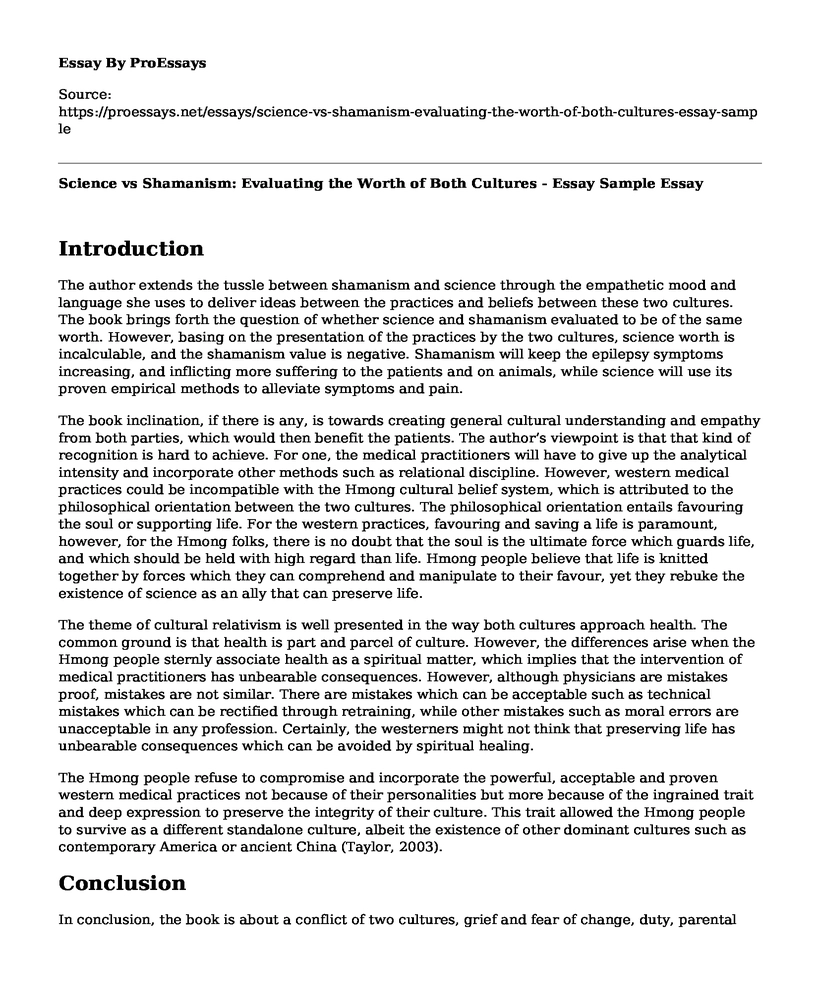Introduction
The author extends the tussle between shamanism and science through the empathetic mood and language she uses to deliver ideas between the practices and beliefs between these two cultures. The book brings forth the question of whether science and shamanism evaluated to be of the same worth. However, basing on the presentation of the practices by the two cultures, science worth is incalculable, and the shamanism value is negative. Shamanism will keep the epilepsy symptoms increasing, and inflicting more suffering to the patients and on animals, while science will use its proven empirical methods to alleviate symptoms and pain.
The book inclination, if there is any, is towards creating general cultural understanding and empathy from both parties, which would then benefit the patients. The author’s viewpoint is that that kind of recognition is hard to achieve. For one, the medical practitioners will have to give up the analytical intensity and incorporate other methods such as relational discipline. However, western medical practices could be incompatible with the Hmong cultural belief system, which is attributed to the philosophical orientation between the two cultures. The philosophical orientation entails favouring the soul or supporting life. For the western practices, favouring and saving a life is paramount, however, for the Hmong folks, there is no doubt that the soul is the ultimate force which guards life, and which should be held with high regard than life. Hmong people believe that life is knitted together by forces which they can comprehend and manipulate to their favour, yet they rebuke the existence of science as an ally that can preserve life.
The theme of cultural relativism is well presented in the way both cultures approach health. The common ground is that health is part and parcel of culture. However, the differences arise when the Hmong people sternly associate health as a spiritual matter, which implies that the intervention of medical practitioners has unbearable consequences. However, although physicians are mistakes proof, mistakes are not similar. There are mistakes which can be acceptable such as technical mistakes which can be rectified through retraining, while other mistakes such as moral errors are unacceptable in any profession. Certainly, the westerners might not think that preserving life has unbearable consequences which can be avoided by spiritual healing.
The Hmong people refuse to compromise and incorporate the powerful, acceptable and proven western medical practices not because of their personalities but more because of the ingrained trait and deep expression to preserve the integrity of their culture. This trait allowed the Hmong people to survive as a different standalone culture, albeit the existence of other dominant cultures such as contemporary America or ancient China (Taylor, 2003).
Conclusion
In conclusion, the book is about a conflict of two cultures, grief and fear of change, duty, parental love, and compounded misunderstandings. The spirit catches you is a bunch of stereotypical beliefs of what the cultural beliefs, think and rules on how to deal with specific situations. The book has no villains or heroes but colossal innocent suffering, as well as a demonstration of moral compass. The lesson of the study is that there is nothing to be learned from tragedy to avoid tragedy. Neither careful thinking, more knowledge, being less stubborn nor being modest because there are no clear morals that can be gained in the face of tragedy. Although the suffering of Lia is an exhibition of adversity, the book also generates some hope in the sense that the medical practitioners at Merced had a comprehensive understanding of cross-cultural medicine. The book advocates for cross-cultural training for the medical professions to improve on their technical ability and moral compass when dealing with cultural complexities.
References
Fadiman, A. (2012). The spirit catches you, and you fall down: A Hmong Child, her American doctors, and the collision of two cultures. Macmillan.
Fadiman, A. (1999). The spirit catches you, and you fall down. New York: Noonday.
Taylor, J. S. (2003). You're attracted to the story, and you're falling down to it: Ethnography, cultural competence and tragedy. Medical Anthropology Quarterly, 17(2), 159-181.
Cite this page
Science vs Shamanism: Evaluating the Worth of Both Cultures - Essay Sample. (2023, Aug 14). Retrieved from https://proessays.net/essays/science-vs-shamanism-evaluating-the-worth-of-both-cultures-essay-sample
If you are the original author of this essay and no longer wish to have it published on the ProEssays website, please click below to request its removal:
- The Iliad and the Archaic Greeks - Essay Sample
- Rules of the Game: The Dean Essay Example
- A Hope More Powerful Than the Sea by Melissa Fleming - Literary Essay Sample
- Essay Example on The Marrow Thieves and Its Exploration of Canadian Identity
- Essay on Equiano's Exposed to English Culture: A Life-Changing Encounter
- Essay Example on Frankenstein: Who Is the Real Monster?
- Critical Essay Sample on "I Felt a Funeral, in my Brain": Emily Dickinson's Unique Style







